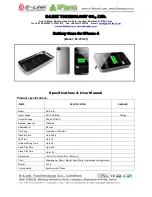
12
Transducer
Mic Level Output
The microphone level output is usable just like any mike out. The Miking Level control on
the Transducer front panel regulates the signal. The Output Gain control has no infl uence on
the Miking Level output. Just as with conventional cabinet miking, variations in microphone
preamp choices may of course be made to infl uence further the sonic result.
Balanced XLR output, wiring: pin 1 = ground, pin 2 = hot (+), pin 3 = cold (-).
Line Output 1
The front panel Output Gain control regulates the output signal, which appears at the Line
Output 1 connector.
Balanced XLR output, line signal with +4dB.
Wiring: pin 1=ground, pin 2=hot (+), pin 3=cold (-).
Line Output 2
The front panel Output Gain control regulates the output signal, which appears at the Line
Output 2 connectors.
Balanced XLR and 1/4” TRS connector, line signal with +4dB.
Wiring XLR: pin 1 = ground, pin 2 = hot (+), pin 3 = cold (-).
Wiring TRS: tip =hot (+), ring = cold (-), sleeve = ground.
The Line Output 2 phase switch provides for a reversal of this output‘s signal phase.
IMPORTANT ADVICE
Use only one (either an XLR or 1/4" TRS) Line Output 2 connection at a time. Using both
output connections simultaneously can impair the signal through impedance mismatches
from the doubled load that can lead to such problems as high frequency damping.
However, Line Output 1 and 2 can be used simultaneously.
Pre Simulator Out
This output is independent from Speaker Simulation and thus independent from Transducer
adjustments. The signal at this Pre Simulator Out is that of the power-reduced amp signal (line
level). With this arrangement you can feed a separate amp and guitar box setup or effects
machines.
Connector variant and connections correspond to industry standards: Unbalanced 1/4" Jack
connector with the signal at tip and ground at sleeve.
Mic Level Output, Line Output 1, Line Output 2 (XLR
or
TRS connection) und Pre Simulator Out
may all be used simultaneously.
Rear Panel
Connections
.*$-&7&-065165
.*$-&7&-
065165
0VUQVU(BJOEPFTOPUBGGFDUUIJTPVUQVU
#BM.JD-FWFM0VUQVU
(/% °
$POOFDUUPNJDQSFBNQMJGJFS
0VUQVU(BJOEPFTOPUBGGFDUUIJTPVUQVU
#BM.JD-FW
FM0VUQVU
(/% °
$POOFDUUPNJDQSFBNQMJGJFS
-*/&065165
-*/&065165
1IBTF
3FWFSTF
/PSNBM
1IBTF
3FW
FSTF
/PSNBM
#BMBODFE-JOF-FWFM0VUQVUT
9-3(/% °
+BDL
5
JQ
3
JOH
°
4MFFWF
(/%
#BMBODFE-JOF-FW
FM0VUQVUT
9-3(/% °
+BDL
5
JQ
3
JOH
°
4MFFWF
(/%
-*/&065165
-*/&065165
#BM-JOF-FWFM0VUQVU
(/% °
#BM-JOF-FW
FM0VUQVU
(/% °
13&4*.6-"503065
13&4*.6-"5
03065
6OCBM-JOF-FWFM0VU
5
JQ
4MFFWF
(/%
$POOFDUUPBEEJUJPOBM
BNQMJGJFSPSFGGFDUT
6OCBM-JOF-FW
FM0VU
5
JQ
4MFFWF
(/%
$POOFDUUPBEEJUJPOBM
BNQMJGJFSPSFGGFDUT
Summary of Contents for Model 2601
Page 1: ...Manual Analog Cabinet and Miking Simulator for E Guitars Transducer Model 2601 ...
Page 10: ...10 Transducer Rear Panel Overview Wiring Examples ...
Page 26: ...26 Transducer Block Diagram ...
Page 27: ...Copy Master Transducer Settings Guitar player Album Gig Title Engineer Track s Group Date ...













































